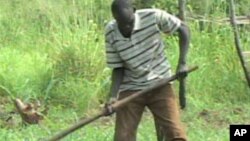At least 4.1 million South Sudanese, or nearly 40 percent of the country’s population, will have trouble getting enough to eat at some point during the year, the report says.
The troubling assessment comes in spite of the fact that food production increased by more than 35 percent between 2011 and 2012, thanks to good rains and improved farming practices.
“South Sudan has tremendous agricultural potential, and the improved harvest estimate is good news, but the country’s overall food security situation remains very precarious,” said WFP Country Director Chris Nikoi in a statement.
“We must redouble efforts to improve the livelihoods of the poorest and most vulnerable South Sudanese, and ensure they can produce their own food or can afford to buy food to meet their needs, and are more resilient to shocks.”
Continuing conflict and economic instability could drive up the number of people requiring food assistance by more than a million over the next year, Sue Lautze, FAO's Head of Office in South Sudan said.
"We are concerned about the double threat of violent insecurity in some states, combined with deepening austerity, which is already putting downward economic pressure on vulnerable populations, including in urban areas," she said.
The report is based on an annual assessment carried out in October and November last year.









